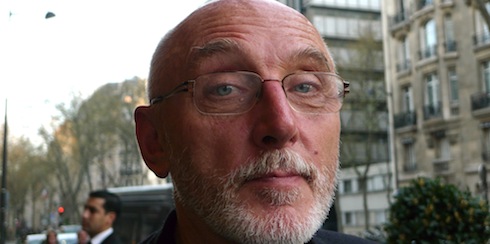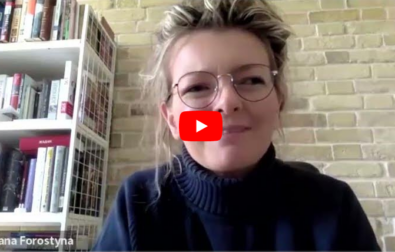For the author ofAux frontières de l’Europe (“At the Frontiers of Europe”) only in few former communist countries and along the external border of the EU can one still encounter the soul of the Old Continent.
How did you get the idea of travelling extensively along the eastern border of the European Union?
I wanted a border that really still was one. As I come from Trieste, I consider myself a son of the border. I was born the same day that the border was drawn around Trieste, on December 20, 1947. This boundary was dismantled exactly sixty years later to the day [when several countries of eastern Europe entered the Schengen area], which coincides, of course, with my sixtieth birthday. That evening my Polish partner [photographer Monika Bulaja] and I looked at each other, and we said: “After wanting this border gone for sixty years, how are we going to handle it, now that it’s no longer there?” It was a wonderful invitation to travel: where has that sense of mystery, which was always wrapped up with the border, gone off to? That day, a little tipsy, a little euphoric, as we were taking down the old Yugoslav border barrier in the middle of a forest in the valley of Rosandra, where you can find the last Italian inn before Yugoslavia, I decided that I would go looking for that real frontier: a place where I would still find genuine border guards.
Did you find them?
And how! Can you imagine? If I had made this trip twenty-five years ago, once I had crossed back into Slovenia I would never have had to show my passport, because I would have been inside the zone of the Warsaw Pact and the former USSR. This time, however, the continual coming and going from the Schengen area and the European Union (EU) meant that I found myself – especially between Norway and Russia and between Latvia and Russia – facing frontiers of an incredible rigidity, far tougher than they were before the Wall fell. I wanted to see what there was behind this barrier, this limit. One quickly grasps that there is no difference between one side of the border and the other, despite these absurd barriers, and that in fact the line of the EU frontier runs along a series of trans-boundary regions with wonderful names, like Courland [Lithuania] or Bothnia [Scandinavia] or Dobrudja [Romania / Bulgaria], which existed before the great nationalist fever of the nineteenth century. These are the names and regions that make up the true heart of the continent.
The geographical centre of Europe, one hears, is somewhere in western Ukraine...
Europe has several centres. One is in Lithuania, one in the Carpathians, one in Poland. It depends on how we measure Europe. What is certain is that Europe is higher than it is wide. The centre of Europe right now is nothing more than a pale imitation of the West, even if strong traces of the East are found in it. This mixture of the Slavic and Judaism, which is the profound soul of Europe, I have found only in these border regions. This is where the heart of Europe beats for me, the heart I had heard of and that I was looking for: a certain maternal femininity, great rivers…. It was in Russia, Ukraine, Poland where I found them.
Your story carries an almost immoderate love for the Slavic spirit and the way of life of the people you met. And a kind of disgust towards certain aspects of western Europe. What is the problem of western Europe?
It’s a world that’s more homogeneous, more fake, more celluloid, where time hurries faster every day and burns up in a corrida of e-mails and text messages, where we’ve lost contact with the earth – “zemljia” in Russian. It’s a word that, with “voda”, or water, has followed me throughout my career.
In your book you praise the authenticity of the inhabitants of these border regions. Yet many of them have one wish – to live in western Europe or, at least, to adopt the lifestyle.
That can’t be forgotten, of course. Without telling them that they’re sticking a finger in their own eye, however, we can remind them that not everything is rosy on this side of the border. Older people are aware of it: they realise that the solidarity that once marked relations among people is no longer there among the Westernised youth.
You often mention the “Slavic soul” in your book. How would you define it?
Slavs are aware that they are not the brains of the continent, but of being, somewhat, its guts. They let their instincts come to the surface. While this may lead to an incredible aggressiveness, in other situations it gives rise to an unforgettable tenderness. In my book I write of a scene in Minsk, where a group of young women come up to a musician playing an accordion and tell him: “Come on, Igor, make us cry!” A Westerner would never have done it. He would have needed a song to anesthetise that life that’s going by too fast, too senselessly. It’s what I like about the Slavs – this sharing of the shadowy part of their lives, of the melancholia.
Has the accession of ten former communist countries to the EU changed Europe?
Yes, because they’ve brought an infusion of dramatic nationalism. From this point of view, the Poles have been a disaster. This feeling that they’re a martyr people who stood up to the Communist moloch. They’ve rediscovered nationalism after the end of nationalism. In Poland it’s pathological. It’s a world centred on itself. What happened with the plane that crashed carrying President Lech Kaczynski and all the other leaders [which went down in Smolensk in April 2010] is a good example: there was no question of the Russians taking them for fools!
In your book you seem to make complaints against Europe and its institutions....
I blame Europe and Italy for being asleep, for not being aware of the nationalist and centrifugal forces that are tugging it apart. We have not remembered the lesson from the Balkans: it’s enough simply to identify an enemy to a people short of reference points for that people to take it on as truth. Today, a ruling class facing collapse that would like to transform a political standoff into an ethnic standoff would have no trouble doing so. We no longer have the anti-fascist antibodies, but nor do we have the antibodies of criticism, either. From this point of view, Italy – but Belgium too – are risk areas. One finds there an exasperated regionalist victimisation. It’s a form of resentment of the periphery towards the centre.
Interview by Gian Paolo Accardo
Was this article useful? If so we are delighted!
It is freely available because we believe that the right to free and independent information is essential for democracy. But this right is not guaranteed forever, and independence comes at a cost. We need your support in order to continue publishing independent, multilingual news for all Europeans.
Discover our subscription offers and their exclusive benefits and become a member of our community now!












